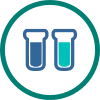An Introduction to ELISA (Part 1)
Written/Edited by Dr. Stefan Pellenz, PhDIntroduction
Enzyme Linked Immunosorbent Assays (ELISAs) are some of the most common wet-lab proteomics assays in use today. The ELISA was born from an older assay design, the Radiometric Immuno-Assay. The RIA utilizes radioactive reagents, which pose a significant risk to human health and safety if handled improperly. The first ELISAs were developed to circumvent this danger and create a fast, simple, and safe alternative. While RIAs are still used in some contexts, they have largely been replaced by the safer, less technically intensive ELISA. Like its predecessor, the ELISA is an antibody-based method designed to quantitatively or qualitatively detect a specific analyte in a sample. Analytes assayed by the ELISA method are commonly (but not necessarily) proteins, and sample types can range from raw biological fluids (e.g. plasma, serum, urine, perspirant) to refined cell culture media or purified recombinant protein in solution.
Looking for high-quality ELISA kits?
We offer a huge variety of ELISA kits for more than 3,000 different targets with references, images, validation data.
Discover our ELISA kit portfolioWhile there are many different kinds of ELISAs, the basic principle behind the assay is strikingly simple: antibodies conjugated to an enzyme (most commonly a peroxidase) are bound to an analyte that has been immobilized on a solid support (commonly a 96-well microtiter plate). The sample is washed, and any unbound antibody is rinsed away. A colorless chromogenic substrate is then introduced, and the enzyme conjugate catalyzes a reaction that transforms the colorless substrate into a dark-colored derivative. The change in color is used to confirm presence of the analyte in a qualitative assay, and in a quantitative assay the degree of colorimetric shift can be compared to the shift observed from a set of known concentration standards to estimate the quantity of analyte present.
Is an ELISA the right assay for me?
The ELISA is renowned as a fast, simple, and accurate assay that allows for either quantitative or qualitative detection of analyte in a sample. There are a few qualifications to consider when deciding if the ELISA is a compatible assay for your intended purpose. In order to be a viable candidate for use in an ELISA, an analyte and sample should meet at least the following basic criteria:
- The analyte must be able to be recognized by an antibody.
- The analyte must be present in an aqueous sample of an appropriate volume. (Usually 50-200μL after dilution).
- The sample must not contain any substance that will interfere with antigen recognition or colorimetric detection.
- The analyte must be in significant enough quantity within the sample to make detection possible.
In addition to knowing what sort of samples are compatible with ELISA, it is also helpful to know which sort of samples are incompatible with the ELISA format. Sample types or analytes may be incompatible with the ELISA format for a variety of technical reasons. The following are a few examples of qualifications that would traditionally make a sample incompatible with ELISA:
- Analytes that are present in only trace amounts within a sample.
- Analytes for which antibody generation is non-trivial. (e.g. very small molecules)
- Samples that contain detergents, strong acids, or strong bases.
- Samples containing dark colored pigments that may stain a microtiter plate or similar solid support.
Note: If an ELISA won't fit for one technical reason or another, antibodies-online can usually offer a different solution. e.g. For small molecule targets that are difficult or impractical to assay by ELISA we may be able to offer a biochemical assay kit. If you're having trouble finding the right tools to carry out a difficult experiment, ask one of our skilled technical support scientists. They may be able to present you with an option that you hadn't considered.
The ELISA has quite a few advantages. It is a rapid, scalable, and specific assay making it a powerful and indispensable tool in the researcher's tool-box. Results obtained can be qualitative, semi-quantitative, or fully quantitative (depending on the design of the assay performed). The ELISA technique is profoundly ingenious in it's simplicity, once an individual assay is optimized a minimally trained technician can usually analyze between 100-200 samples via ELISA in just a few hours. Standards and samples are commonly run in duplicate (at least) making the ELISA a fairly robust assay and more tolerant to user error or stochastic sample variation than many alternate methods.
Still, the ELISA is not without limitations. The basic nature of an ELISA limits a single assay to detection of a single target. Because the assay is dependent upon binding of the analyte by an antibody an ELISA cannot distinguish between antigenically identical analytes (different targets that are recognized by the same antibody). For example the same ELISA assay will often recognize many or all different isoforms of the same protein in a sample. The assay also requires the availability of some specialized equipment, like a spectrophotometric microplate reader, to properly conduct the assay. The ELISA format is also most cost effective when assaying many samples. A single 96-test kit is generally capable of assaying 40 samples in duplicate as well as an 8-sample standard curve. Many researchers find the cost of an ELISA kit prohibitive for small studies investigating just a handful of samples.
Note: If you need to assay multiple targets in one convenient step, you might be interested in our broad selection of "multiplex assays and antibody-arrays.
The chief disadvantages associated with ELISA have largely been mitigated by advancement in technology. Today most academic and private research institutions possess the specialized plate readers and other equipment necessary to carry out the various steps in an ELISA. Additionally, competition in the market has driven the price of premade ELISA kits down, and they generally offer a better value per sample assayed than many other common proteomics methods. However, one should still carefully consider ones choice of experimental design and weigh the strengths and weaknesses of the ELISA format against all options when making the vital decision regarding which techniques to leverage.
Build an assay, or buy a kit?
Once you’ve decided that you’d like to use an ELISA, you need to decide whether you’ll use a commercially available ELISA kit, or try to compile an assay on your own from scratch. There are a few reasons that one might want to try to generate an assay de novo rather than purchasing a pre-made solution. If you need to fine tune your assay outside the specifications in a commercially available kit, if you need tight control over the specific nature of the components that go in to your assay, or if you need to use a specific or custom antibody in your assay you might want to consider investing the time and effort necessary to generate an assay de novo.
However, if you’re not limited to the criteria above, you might want to consider purchasing a commercially available assay for simplicity’s sake. You should consider purchasing a pre-made kit if you want to:
- Save time: Optimization of custom ELISA is very time consuming. Even for an experienced scientist with compatible reagents, a new assay will generally require hours or days of optimization before it is ready for use. That’s all time that you could be using to collect, analyze, interpret, and publish your data. Carefully consider the value of your time, and the time of the technicians and students who will be building and performing the assay.
- Ensure reagent compatibility: A pre-made ELISA kit is guaranteed to contain reagents that are compatible with each other. When compiling your own assay, even if you choose high quality reagents you may accidentally stumble upon incompatible products (e.g. two antibodies that recognize a similar epitope and block each other due to steric hindrance).
- Avoid frustrating quality-control issues: When generating an assay from scratch, you'll likely be sourcing different reagents from several different places. And after spending all the time necessary to track down each of the various reagents you need, even a single bad buffer could ruin your experiment, requiring countless hours of troubleshooting to trace the source of the problem. By contrast, every pre-made ELISA kit from antibodies-online is covered by our money back guarantee. In the unlikely event that you do experience a problem, our technical support staff will handle the troubleshooting.
- Save money: While it may be tempting to try to piece together your own ELISA to save a few dollars, most researchers find that the cost-benefit analysis doesn't actually add up in the end. After considering all of the different components that must be purchased to generate an assay de novo it is often just as cost effective to buy a pre-made kit.
Whether you've chosen to purchase one of our ready-to-use ELISA kits or develop your own assay from scratch, you probably will want to know a bit more about the different assay designs that are available and common. To learn more about the different ELISA formats that are commonly available at antibodies-online, please see An Introduction to ELISA (Part 2).
What are the advantages of using ELISA Kits?
In order to perform an ELISA you need several materials. A pre-coated 96-well strip plate several diluents, a stop solution, a standard to test against, a substrate in order to generate the color response detection reagents and a wash buffer. This saves time when compared to gathering all materials and mix the solutions prior to each assay. ELISA Kits are a convenient approach to perform your desired ELISA. The kit comes in a box containing all of the necessary reagents at once – no need to buy anything extra.




Selection of our most popular ELISA kit products
- (24)
- (3)
- (1)
- (25)
- (6)
- (13)
- (6)
- (1)
- (1)
- (1)
- (6)
- (1)

Goal-oriented, time line driven scientist, proficiently trained in different academic institutions in Germany, France and the USA. Experienced in the life sciences e-commerce environment with a focus on product development and customer relation management.
Go to author page



